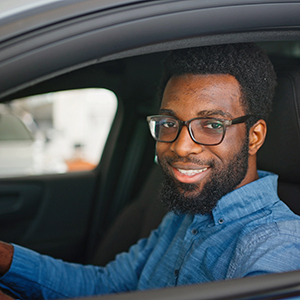Why Having Good Vision Is Essential for Safe Driving

Clear vision is one of the most important factors in safe driving. Around 90 percent of the information drivers rely on comes through their eyes. Regular eye exams are the best way to ensure that your vision stays sharp enough for safe navigation on the road.
These exams can catch age-related eye conditions early, helping you maintain the ability to see signs, detect hazards and react quickly to changing traffic. Keeping your glasses or contact lens prescription up to date is just as critical. Driving with uncorrected or outdated lenses puts everyone on the road at risk.
Why Vision Is Important for Safe Driving
Good vision helps you process information and make quick, accurate decisions while driving. Several visual skills work together to help you stay aware of your surroundings, spot potential hazards and respond in time to avoid collisions.
Visual Acuity
Visual acuity is what lets you see fine details at a distance, like reading road signs or spotting brake lights ahead. A person with 20/20 vision can read letters that are the size of the tip of a pencil held at arm's length.
Drivers with reduced acuity often need to be much closer to something to see it clearly, which can delay reaction time. Even minor uncorrected vision problems can interfere with identifying road signs, traffic signals and hazards in time to respond safely.
Peripheral Vision
Peripheral vision allows you to detect movement and objects outside of your direct line of sight without turning your head. It's necessary for maintaining awareness of surrounding vehicles, cyclists and pedestrians.
Losing peripheral vision can be especially dangerous, since it may prevent you from noticing movement in adjacent lanes or at intersections. Studies show that limited side vision increases the risk of crashes more than slightly reduced sharpness of sight does.
Depth Perception
Depth perception, or stereopsis, helps you judge distance accurately by combining the slightly different views from each eye. It's essential for merging, parking, passing other vehicles and stopping at a safe distance. Poor depth perception can cause errors in judging how close another car or object is, increasing the risk of accidents.
Night Vision and Glare Recovery
Driving at night places heavy demands on your vision. Glare from oncoming headlights can temporarily reduce visibility, especially as you age, and the ability for your eyes to readjust afterward slows over time, making it harder to see after encountering bright lights.
The intensity of modern headlights can make this problem worse. Drivers who struggle with glare should take extra care by making sure that their windshields are clean and by avoiding high-beam exposure whenever possible.
Common Vision Conditions That Affect Driving
Several eye conditions can interfere with safe driving. Recognizing them early can prevent serious accidents and help maintain your independence.
Cataracts
Cataracts cause the lens of the eye to become cloudy, leading to blurred or distorted vision. Drivers with cataracts often struggle to see road signs, especially at night or in low light. Glare from headlights or sunlight can be blinding, and depth perception often worsens as the condition progresses.
Glaucoma
Glaucoma damages the optic nerve, gradually narrowing peripheral vision until it feels like looking through a tunnel. Because the condition develops silently, many drivers don't realize their side vision is fading until it's significantly impaired. Losing peripheral awareness greatly increases the risk of sideswipe collisions or failing to notice pedestrians and cyclists.
Macular Degeneration
Macular degeneration affects central vision, making it harder to see directly ahead. This can make it difficult to read street signs, identify lane markings or judge distances.
People with early-stage macular degeneration may still drive safely, but frequent eye exams are essential to monitor changes and determine when driving may no longer be safe.
Refractive Errors
Refractive errors, such as nearsightedness, farsightedness and astigmatism, occur when the eye doesn't focus light properly. Uncorrected vision can make distant objects blurry or cause problems switching focus between the dashboard and the road. These issues are especially dangerous at night, when even minor blur can distort lights and reduce visibility.
Driving Tips for People With Glasses or Contacts
If you use corrective lenses, a few habits can help keep you safe behind the wheel:
- Always wear your current prescription. Replace lost or damaged lenses immediately rather than relying on an old pair.
- Avoid using tinted or photochromic lenses at night, as they reduce visibility.
- Keep your windshield, mirrors and lenses clean to minimize glare.
- Sit high enough to see at least ten feet of the road ahead, which helps to reduce glare from oncoming headlights.
- Keep a backup pair of glasses in your car in case your primary pair breaks.
- When facing oncoming headlights at night, look toward the lower right edge of the road to minimize the blinding effect of the lights.
When Older Adults Should Get Their Vision Checked
As people age, vision naturally declines, so drivers 60 and older should have a comprehensive eye exam every one to two years. Regular checkups help detect cataracts, glaucoma and macular degeneration before they significantly affect driving ability. Any sudden vision changes should be evaluated right away. Early diagnosis and treatment can preserve both safety and independence.
- Older Driver Safety
- Study on Age-Related Driving Abilities
- Older Adult Driving Safety
- Florida Driver Training
- Online DETS Course for Drivers
- TLSAE Driver Education
- Virginia Driver Training Online
Safe driving depends on accurate, reliable vision. Regular eye exams help maintain key visual abilities that are essential for reacting to traffic and hazards, and detecting and managing eye conditions early allows drivers to make smart adjustments, such as limiting night driving or updating corrective lenses. Maintaining strong visual health means maintaining freedom, confidence and safety behind the wheel.

